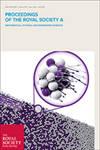二维指数梯度弹性介质的格林函数
Proceedings of the Royal Society of London. Series A. Mathematical and Physical Sciences
Pub Date : 2004-06-08
DOI:10.1098/rspa.2003.1220
引用次数: 88
摘要
导出了二维指数梯度弹性介质的自由空间格林函数。假设剪切模量Âμ是笛卡尔坐标(x,y)的指数函数,即μ≡μ(x,y) = μ0e2(β1x+β2y),其中μ0、β1和β2为材料常数,泊松比为常数。格林函数由奇异部分(包含修正贝塞尔函数)和非奇异项组成。非奇异分量用一维傅里叶型积分表示,这种积分可以通过快速傅里叶变换计算得到。本文章由计算机程序翻译,如有差异,请以英文原文为准。
Green's function for a two–dimensional exponentially graded elastic medium
The free–space Green function for a two–dimensional exponentially graded elastic medium is derived. The shear modulus Âμ is assumed to be an exponential function of the Cartesian coordinates (x,y), i.e. μ ≡ μ(x,y) = μ0e2(β1x+β2y), where μ0, β1, and β2 are material constants, and the Poisson ratio is assumed constant. The Green function is shown to consist of a singular part, involving modified Bessel functions, and a non–singular term. The non–singular component is expressed in terms of one–dimensional Fourier–type integrals that can be computed by the fast Fourier transform.
求助全文
通过发布文献求助,成功后即可免费获取论文全文。
去求助
来源期刊
自引率
0.00%
发文量
0
期刊介绍:
Proceedings A publishes articles across the chemical, computational, Earth, engineering, mathematical, and physical sciences. The articles published are high-quality, original, fundamental articles of interest to a wide range of scientists, and often have long citation half-lives. As well as established disciplines, we encourage emerging and interdisciplinary areas.

 求助内容:
求助内容: 应助结果提醒方式:
应助结果提醒方式:


